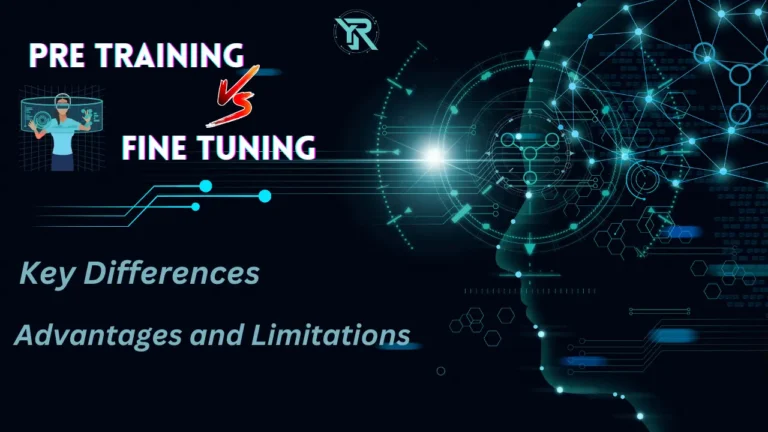Pre Training Vs Fine Tuning :- Hello Everyone Today we are talking about in this article that the world of machine learning is expanding and in it pre training vs fine tuning both are playing a role.
As technology is advancing, do you know what is the difference between the two and which way is better? Well, today we are going to discuss in depth the subject of Pre Training Vs Fine Tuning.
Pre training vs fine tuning are both based on the basic principles of machine learning, but they are used for different purposes. Come, let’s start and understand what is the difference between pre training vs fine tuning.
Table of Contents
What Is Pre Training?
Pre training is an important process of machine learning where we train the model beforehand. That is, we introduce the model with a lot of data so that the language can be understood. This process provides a basic understanding of the model of language, such as grammar and reasoning.
During pre-training, the model is introduced to diverse texts, such as books, articles, and websites. In this process the model tries to understand grammar rules, linguistic patterns, and factual information. This is a very important step in machine learning, which prepares us for specific tasks.
What Is Fine Tuning?
Fine tuning means customizing a previously trained model to your liking or for a specific task. When we train a pre-trained model for a new task, it is called fine tuning. This is an important step in machine learning, especially when we have limited resources for data.
When we do fine tuning, we train the pre-trained model with a new dataset that is related to our new task. This way, the model takes advantage of what it learned in the previous training process, making it better suited to the task. During fine tuning, the model’s weights are adjusted, and some layers may also be unfreezed, so that they can be better prepared for the task.
One of the benefits of fine tuning is that this process completes the training faster, because the model has already learned a lot. Moreover, fine tuning uses less data, which is very beneficial for limited datasets.
Bert Pre Training Vs Fine Tuning LLM
| Features | BERT Pre-Training | Fine-Tuning of LLM |
| Definition | Initial training on a large, general dataset | Subsequent training on a task-specific dataset |
| Purpose | Develop a general understanding of language | Customize the model for a specific task |
| Dataset Size | Large dataset (e.g., Wikipedia, Book Corpus) | Smaller, task-specific dataset |
| Training Method | Unsupervised learning | Transfer learning |
| Adjustments | Model learns grammar, syntax, facts | Model adapts to domain-specific features |
| Process | Understand language nuances and patterns | Specialize in a particular task or domain |
| Examples | Sentence prediction, masked language modeling | Text classification, question answering |
| Flexibility | Less flexible, general-purpose model | More flexible, task-specific model |
| Resource Usage | High computational resources for pre-training | Lower computational resources for fine-tuning |
| Expertise Needed | Deep understanding of machine learning principles | Technical knowledge of domain-specific tasks |
| Data Requirement | Large, diverse dataset for pre-training | Smaller, labeled dataset for fine-tuning |
Key Differences Between Pre training Vs Fine tuning
- Purpose: In pre-training, the model is trained on a large general dataset to learn general language. In fine tuning, the pre-trained model is optimized for a specific task.
- Dataset size: In pre-training, large datasets are used, such as Wikipedia or Book Corpus. In fine tuning, a smaller dataset is used that is used for specific tasks.
- Training Method: In pre-training, the model is animated. In fine tuning, the knowledge previously taught to the model is applied to a new task.
- Process: In pre-training the rules and principles of the language are taught. In fine tuning, the model gains expertise in a particular task or area.
- Flexibility: In pre-training, the model is less flexible, whereas in fine tuning, the model is more flexible as it adapts to the task domain.
- Resource Usage: In pre-training, more computational resources are required. In fine tuning, less computational resources are required.
- Required Knowledge: In pre-training, a deep understanding of the principles of machine learning is required. Fine tuning requires specific knowledge of the work area.
- Data Requirement: In pre-training, large and diverse datasets are required. In fine tuning, small and labeled datasets are required.
Advantages and Limitations
Benefits of BERT Pre-Training:
- General Understanding: Pre-training helps the model understand the basics of the language, including grammar, syntax, and common sense.
- Versatility: Pre-trained models can be used for different tasks without retraining, saving time and resources.
- High Performance: Models pre-trained on large datasets perform well on a wide range of language tasks due to their comprehensive understanding of language nuances.
- Transferability: Pre-trained models can be fine-tuned for specific tasks, taking advantage of the knowledge gained during pre-training to adapt it to new domains.
- Availability: Pre-trained models like BERT are publicly available, allowing developers to use them as a basis for their projects without having to start from scratch.
Limitations of BERT Pre-Training:
- Resource-intensive: Pre-training large language models requires significant computational resources and time due to the sheer amount of data involved.
- Domain-Specific Knowledge: Pre-trained models may lack the specialized knowledge required for specific tasks, requiring fine-tuning to achieve optimal performance.
- Bias Propagation: Pre-trained models can acquire biases present in the training data, which can affect their performance and reliability in some applications.
- Limited Adaptability: Pre-trained models may not be suitable for tasks very different from the datasets they were trained on, requiring extensive fine-tuning or training from scratch.
- Complexity: Understanding and effectively using pre-trained models like BERT may require a deep understanding of machine learning principles and NLP techniques, which poses a barrier for beginners.
Examples of Pre Training For A Large Language Model (LLM)
Examples of Pre-Training for a Large Language Model (LLM):
- GPT (Generative Pre-trained Transformer) Series: Models like GPT-3, developed by OpenAI, are prime examples of pre-training for LLMs. GPT-3 was pre-trained on a vast dataset consisting of diverse texts from the internet, allowing it to generate human-like text across various domains.
- BERT (Bidirectional Encoder Representations from Transformers): BERT, developed by Google, is another notable example of pre-training for LLMs. It was trained on a large corpus of text from books, articles, and websites, enabling it to understand language contextually and perform well on various NLP tasks such as text classification and question answering.
- XLNet: XLNet, developed by Google AI, is a transformer-based model pre-trained on a massive dataset using an autoregressive language modeling objective. It incorporates permutation language modeling, allowing it to capture bidirectional context more effectively than previous models.
- T5 (Text-To-Text Transfer Transformer): T5, developed by Google Research, is a versatile LLM pre-trained on a diverse range of tasks using a unified text-to-text framework. It can be fine-tuned for various NLP tasks by framing them as text-to-text problems, demonstrating the effectiveness of pre-training for multitask learning.
- RoBERTa (Robustly optimized BERT approach): RoBERTa, developed by Facebook AI, is an optimized version of BERT pre-trained on a larger corpus of text with additional training data and longer sequences. It achieves state-of-the-art performance on various downstream tasks by leveraging extensive pre-training.
These examples illustrate the effectiveness of pre-training for LLMs, enabling them to learn from vast amounts of data and generalize well to various language tasks and domains.
Conclusion: Pre Training vs Fine Tuning
Pre training vs fine tuning are pivotal processes in machine learning, each serving distinct roles in model development. Pre-training lays the groundwork by providing a broad understanding of language to the model, while fine-tuning refines this knowledge for specific tasks or domains.
While pre-training endows the model with a comprehensive grasp of language and adaptability, fine-tuning hones its performance and flexibility for particular tasks, often in scenarios with limited data. Both methods offer advantages and face limitations, necessitating careful consideration based on project requirements and resource availability.
As technology advances, the deep learning community is increasingly inclined towards hybrid approaches that amalgamate the strengths of both pre training vs fine tuning. This trend is anticipated to persist, propelling further innovation and enhancement in machine learning models and their applications.
Understanding the distinctions and applications of pre-training versus fine-tuning is paramount for unlocking the full potential of machine learning in addressing real-world challenges across diverse domains.
FAQ
Q: What is BERT pre-training?
ANS: Pretraining of BERT establishes a foundational understanding from which it generates responses. This enables BERT to adjust to the expanding pool of searchable content and user queries, and it can be customized to meet specific user needs. This methodology is referred to as transfer learning.
Q: What is LLM pretraining?
ANS: During pre-training, a Large Language Model lays the groundwork by obtaining essential knowledge and abilities, paving the way for future specialization in particular tasks. Consider pre-training akin to educating a young intellect, imbuing it with the fundamental elements of language before it hones its skills to meet specific demands.
Q: What is the purpose of pre-training?
ANS: The concept of Pre-Training suggests that educators should introduce fundamental terms and ideas before delving into the main lesson content to alleviate cognitive burden on learners.
Q: How big is BERT pretraining?
ANS: To begin, we import the WikiText-2 dataset in the form of minibatches, which serve as pretraining instances for masked language modeling and predicting the next sentence. Each batch consists of 512 examples, and the maximum length of a BERT input sequence is set to 64. It’s worth noting that the original BERT model had a maximum sequence length of 512.
Q: What is fine-tuning in BERT model?
ANS: Adapting a pre-trained BERT model for a specific downstream task involves fine-tuning the model using training data tailored to that particular job, typically by training a new layer.

